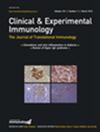Exploring the Causal Role of Immune Cells in Cerebral Aneurysm Through Single-Cell Transcriptomics and Mendelian Randomization Analysis.
IF 3.4
3区 医学
Q3 IMMUNOLOGY
引用次数: 0
Abstract
Cerebral aneurysm (CA) represent a significant clinical challenge, characterized by pathological dilation of cerebral arteries. Recent evidence underscores the crucial involvement of immune cells in CA pathogenesis. This study aims to explore the complex interplay between immune cells and CA formation. We analyzed single-cell RNA sequencing data from the GSE193533 dataset, focusing on unruptured CA and their controls. Comprehensive cell-type identification and pseudotime trajectory analyses were conducted to delineate the dynamic shifts in immune cell populations. Additionally, a two-sample Mendelian Randomization (MR) approach was employed to investigate the causal influence of various immunophenotypes on CA susceptibility and the reciprocal effect of CA formation on immune phenotypes. Single-cell transcriptomic analysis revealed a progressive loss of vascular smooth muscle cells (VSMCs) and an increase in monocytes/macrophages (Mo/MΦ) and other immune cells, signifying a shift from a structural to an inflammatory milieu in CA evolution. MR analysis identified some vital immunophenotypes, such as CD64 on CD14+ CD16+ monocytes (OR: 1.236, 95% CI: 1.064 to 1.435, p=0.006), as potential risk factors for CA development, while others, like CD28- CD8br %CD8br (OR: 0.883, 95% CI: 0.789 to 0.988, p=0.030), appeared protective. Reverse MR analysis demonstrated that CA formation could modulate specific immunophenotypic expressions, highlighting a complex bidirectional interaction between CA pathology and immune response. This study underscores the pivotal role of immune cells in this process through the integration of single-cell transcriptomics with MR analysis, offering a comprehensive perspective on CA pathogenesis, potentially guiding future therapeutic strategies targeting specific immune pathways.通过单细胞转录组学和孟德尔随机分析探索免疫细胞在脑动脉瘤中的因果作用
脑动脉瘤(CA)是一项重大的临床挑战,其特征是脑动脉的病理性扩张。最近的证据表明,免疫细胞在 CA 的发病机制中起着至关重要的作用。本研究旨在探索免疫细胞与 CA 形成之间复杂的相互作用。我们分析了 GSE193533 数据集中的单细胞 RNA 测序数据,重点是未破裂的 CA 及其对照组。我们进行了全面的细胞类型鉴定和伪时间轨迹分析,以描述免疫细胞群的动态变化。此外,还采用了双样本孟德尔随机化(MR)方法来研究各种免疫表型对CA易感性的因果影响,以及CA形成对免疫表型的相互影响。单细胞转录组分析显示,血管平滑肌细胞(VSMC)逐渐减少,单核细胞/巨噬细胞(Mo/MΦ)和其他免疫细胞增加,这表明在CA演变过程中,环境已从结构性转变为炎症性。磁共振分析确定了一些重要的免疫表型,如 CD14+ CD16+ 单核细胞上的 CD64(OR:1.236,95% CI:1.064 至 1.435,p=0.006),是 CA 发生的潜在危险因素,而其他免疫表型,如 CD28- CD8br %CD8br(OR:0.883,95% CI:0.789 至 0.988,p=0.030),则具有保护作用。反向磁共振分析表明,CA 的形成可调节特定的免疫表型表达,突出了 CA 病理和免疫反应之间复杂的双向相互作用。这项研究通过将单细胞转录组学与磁共振分析相结合,强调了免疫细胞在这一过程中的关键作用,为CA的发病机制提供了一个全面的视角,有可能指导未来针对特定免疫通路的治疗策略。
本文章由计算机程序翻译,如有差异,请以英文原文为准。
求助全文
约1分钟内获得全文
求助全文
来源期刊
CiteScore
8.40
自引率
2.20%
发文量
101
审稿时长
3-8 weeks
期刊介绍:
Clinical & Experimental Immunology (established in 1966) is an authoritative international journal publishing high-quality research studies in translational and clinical immunology that have the potential to transform our understanding of the immunopathology of human disease and/or change clinical practice.
The journal is focused on translational and clinical immunology and is among the foremost journals in this field, attracting high-quality papers from across the world. Translation is viewed as a process of applying ideas, insights and discoveries generated through scientific studies to the treatment, prevention or diagnosis of human disease. Clinical immunology has evolved as a field to encompass the application of state-of-the-art technologies such as next-generation sequencing, metagenomics and high-dimensional phenotyping to understand mechanisms that govern the outcomes of clinical trials.

 求助内容:
求助内容: 应助结果提醒方式:
应助结果提醒方式:


